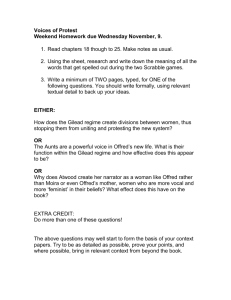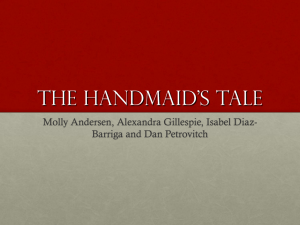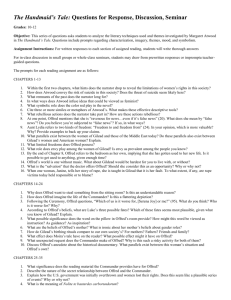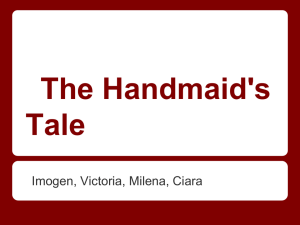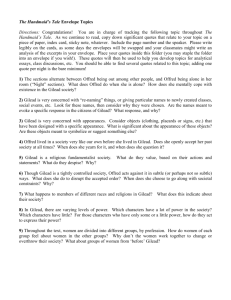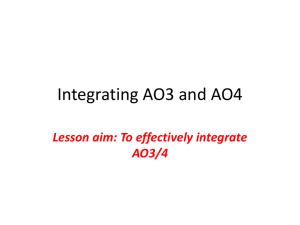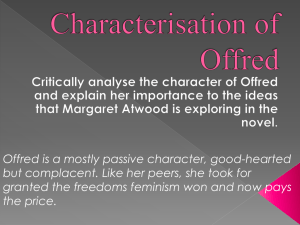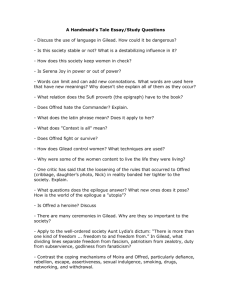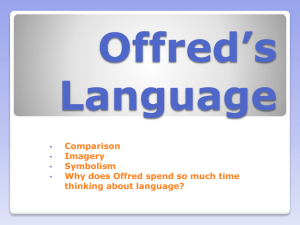Narrative - englishwithmorgan
advertisement
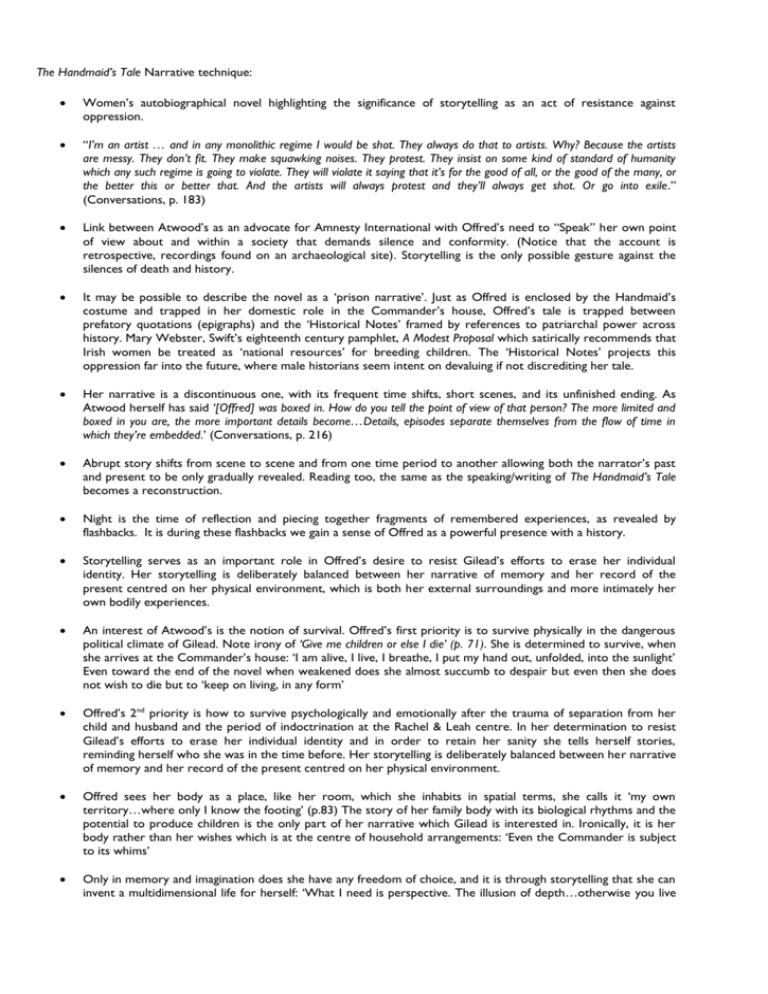
The Handmaid’s Tale Narrative technique: Women’s autobiographical novel highlighting the significance of storytelling as an act of resistance against oppression. “I’m an artist … and in any monolithic regime I would be shot. They always do that to artists. Why? Because the artists are messy. They don’t fit. They make squawking noises. They protest. They insist on some kind of standard of humanity which any such regime is going to violate. They will violate it saying that it’s for the good of all, or the good of the many, or the better this or better that. And the artists will always protest and they’ll always get shot. Or go into exile.” (Conversations, p. 183) Link between Atwood’s as an advocate for Amnesty International with Offred’s need to “Speak” her own point of view about and within a society that demands silence and conformity. (Notice that the account is retrospective, recordings found on an archaeological site). Storytelling is the only possible gesture against the silences of death and history. It may be possible to describe the novel as a ‘prison narrative’. Just as Offred is enclosed by the Handmaid’s costume and trapped in her domestic role in the Commander’s house, Offred’s tale is trapped between prefatory quotations (epigraphs) and the ‘Historical Notes’ framed by references to patriarchal power across history. Mary Webster, Swift’s eighteenth century pamphlet, A Modest Proposal which satirically recommends that Irish women be treated as ‘national resources’ for breeding children. The ‘Historical Notes’ projects this oppression far into the future, where male historians seem intent on devaluing if not discrediting her tale. Her narrative is a discontinuous one, with its frequent time shifts, short scenes, and its unfinished ending. As Atwood herself has said ‘[Offred] was boxed in. How do you tell the point of view of that person? The more limited and boxed in you are, the more important details become…Details, episodes separate themselves from the flow of time in which they’re embedded.’ (Conversations, p. 216) Abrupt story shifts from scene to scene and from one time period to another allowing both the narrator’s past and present to be only gradually revealed. Reading too, the same as the speaking/writing of The Handmaid’s Tale becomes a reconstruction. Night is the time of reflection and piecing together fragments of remembered experiences, as revealed by flashbacks. It is during these flashbacks we gain a sense of Offred as a powerful presence with a history. Storytelling serves as an important role in Offred’s desire to resist Gilead’s efforts to erase her individual identity. Her storytelling is deliberately balanced between her narrative of memory and her record of the present centred on her physical environment, which is both her external surroundings and more intimately her own bodily experiences. An interest of Atwood’s is the notion of survival. Offred’s first priority is to survive physically in the dangerous political climate of Gilead. Note irony of ‘Give me children or else I die’ (p. 71). She is determined to survive, when she arrives at the Commander’s house: ‘I am alive, I live, I breathe, I put my hand out, unfolded, into the sunlight’ Even toward the end of the novel when weakened does she almost succumb to despair but even then she does not wish to die but to ‘keep on living, in any form’ Offred’s 2nd priority is how to survive psychologically and emotionally after the trauma of separation from her child and husband and the period of indoctrination at the Rachel & Leah centre. In her determination to resist Gilead’s efforts to erase her individual identity and in order to retain her sanity she tells herself stories, reminding herself who she was in the time before. Her storytelling is deliberately balanced between her narrative of memory and her record of the present centred on her physical environment. Offred sees her body as a place, like her room, which she inhabits in spatial terms, she calls it ‘my own territory…where only I know the footing’ (p.83) The story of her family body with its biological rhythms and the potential to produce children is the only part of her narrative which Gilead is interested in. Ironically, it is her body rather than her wishes which is at the centre of household arrangements: ‘Even the Commander is subject to its whims’ Only in memory and imagination does she have any freedom of choice, and it is through storytelling that she can invent a multidimensional life for herself: ‘What I need is perspective. The illusion of depth…otherwise you live in the moment. Which is not where I want to be’ (p.239). The narrative explores the complex ways the memory works, where te present moment is never self-contained but pervaded by traces of earlier times. Memory more than a breath of nostalgia it is her chief escape mechanism representing ‘somewhere good’ as space and time are collapsed into each other: ‘The night is my time out. Where shall I go? (p. 47) Storytelling is a means of psychological survival Regardless of her ambivalent feelings for the Commander, Offred recognises that it is through their meetings where she can talk and read that she is enabled to return to a lively sense of herself as an individual. Offred tells the stories, and therefore provides a voice for other women (denied a voice by the patriarchal structure of the Gilead Republic) other than herself.: her mother, Moira, Whether women are rebels or willing victims, their chances of survival are slim as the story of Janine illustrates. Her reappearances show the various stages of an handmaid’s career – from willing victim at the Rachel & Leah Centre and near breakdown to her moment of triumph as the pregnant Ofwarren, to her last frightening appearance as madwoman after the Particulation, holding a clump of bloodstained hair. She is a constant reminder of what could happen if Offred ever gives up hope. Offred also tells the story of the Commander’s wife through flashback to here earlier career as Serena Joy on Gospel show. She too has been trapped by Gileadaen ideology. In one of Offred’s odder anecdotes she even has to wear the blue cloak and looks at her own face in Serena Joy’s silver mirror. Her writing is both exemplary and symbolic in giving voice to other women historically excluded & silenced by the patriarchal tradition of the Old Testament. Postmodern contemporary nature of Atwood is shown as Offred continuously draws our attention to her storytelling techniques. She addresses the reader as ‘Dear You’ deliberately drawing the reader into the action as it happens, commentating on the way that the act of telling shapes and changes real experiences, and providing reasons for telling her story. (Chp 7, 23, 40 & 41) Offred is a self conscious narrator (like Atwood herself) who recognises that texts are created by their readers as well as the writers. This means that Offred does not have ultimate authority over the ‘meaning’ of her story. Indeed, she often questions herself on the reality or the degree of how true her story is. Although we are reading Offred’s oral narrative, it is actually a woman’s oral narrative. Note that she is not an entirely honest or reliable narrator. In chapter 40 she provides several versions of her encounter with Nick. At the end she says ‘It didn’t happen that way either. I’m not sure how it happened, not exactly” (275) Memory, like language is not entirely reliable when it comes to reconstructing reality. For Offred storytelling performs many functions: her main survival technique, to record her present circumstances in an eye-witness account, but also serves as an escape mechanism into memory. It is also a substitute for dialogue as the narrator invents her listeners “by telling you anything at all, I’m at least believing in you, I believe you’re there, I believe you into existence’ (279) Storytelling presents the only method she has of sending a message to the outside world, trusting that one day it will be delivered. ‘A story is like a letter. Dear you, I’ll say. Just you, without a name…You can mean thousands’ (p. 50) Note historical notes introduces another narrator, in another place, at another time, projecting another interpretation (of history, of women, of the authenticity & accuracy of Offred’s tale) Your turn: 1. Prepare a quick visual/brainstorm summary showing the significance of storytelling in the novel 2. Explain the important role that storytelling plays as a subversive activity 3. Despite the widespread annoyance in the room regarding the fragmented style of the novel, in light of the above notes can you present an argument for why this fragmented approach is not only advantageous but also necessary? 4. Comment on the relationship that is fostered between Offred and the reader. How does Atwood establish & maintain this relationship? 5. Before we look at the Historical notes closely, consider their function and purpose in the novel. Why are they there? What messages about Offred are confirmed or rejected?
